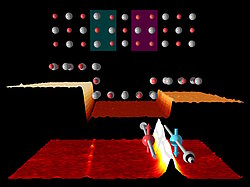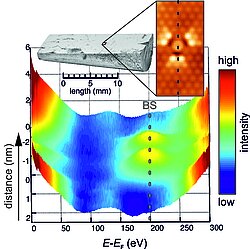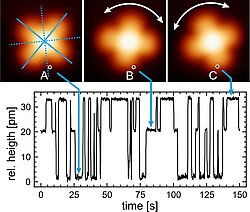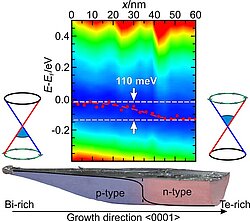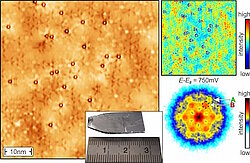2016
Image & Results Gallery (2016 archive)
Discovery of robust spin-polarized edge states on topological crystalline insulators
December 9, 2016
Topological crystalline insulators are materials in which the crystalline symmetry leads to topologically protected surface states with a chiral spin texture, rendering them potential candidates for spintronics applications. Using scanning tunneling spectroscopy, we uncovered the existence of one-dimensional (1D) midgap states at odd-atomic surface step edges of the three-dimensional topological crystalline insulator (Pb,Sn)Se. A minimal toy model and more realistic tight-binding calculations identified these edge states as spin-polarized flat bands connecting two Dirac points, as described in Science 354, 1269 (2016).
Their nontrivial origin provides them with inherent stability and protects them from backscattering. We experimentally showed that this stability results in a striking robustness to defects, strong magnetic fields, and elevated temperature. In principle, the finding of 10 nm narrow one-dimensional edge states may allow for the creation of well-separated conductive channels by patterning the step- and-terrace structure of TCI surfaces. This may lead to interconnections between functional units at ultrahigh packing densities.
Visualizing anisotropic propagation of stripe domain walls
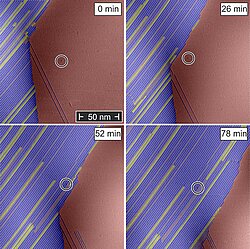
December 7, 2016
First-order phase transitions determine many physical phenomena. In the classical Ehrenfest classification the distinction between first- and second- order phase transitions is based on the different behavior of the thermodynamic free energy and its first derivative, the order parameter. While it changes abruptly at TC for first-order transitions, the order parameter changes continuously for second- order phase transitions. However, structural defects such as vacancies or antisite atoms are known to blur this distinction as it broadens first- order transitions such that they appear continuous in spatially averaged measurements.
In a recent study performed in cooperation with scientists at Rutgers University (USA) we identified very different processes not related to crystalline defects in the case of the charge density wave-like phase transitions in the 5d transition metal dichalcogenide IrTe2. Our results show strongly anisotropic and very complex domain wall movement processes have been published in Physical Review B. They potentially represent the first direct observation of a “harmless staircase”, which is characterized by a finite number of first-order transitions between commensurate phases and which was originally postulated for oscillating soliton interactions.
On the dual nature of magnetic dopants and competing trends in topological insulators
June 18, 2016
Beyond the fundamental interest in topological insulators (TIs), their unusual electronic properties with a gapped bulk and a surface Dirac cone offer great potential for applications. Ultimately, success will crucially depends on our ability of functionalizing TIs with well-defined perturbations. In this context magnetic dopants play a key role since they break time-reversal symmetry and change the spin-texture. Up to now it is not clear, however, whether magnetic doping leads to a gap opening at the Dirac point.
In a recent publication, which was only possible because of close cooperation with collaborators from Novosibirsk State University (Russia), Los Alamos National Laboratory (USA), and the Istituto di Struttura della Materia in Trieste (Italy), we could provide compelling evidence that the emergence of ferromagnetism gaps the Dirac states but also results in impurity-induced resonances at the Dirac node, thereby leading to the emergence of a two-fluid behavior. Our results, which has been published in Nature Communications, resolve a long-standing debate in the field.
Energetic and Spatial Mapping of Resonant Electronic Excitations
June 14, 2016
Single particle manipulation offers unique possibilities to tune electronic properties of molecular and atomic assemblies and thereby opens new paths for future electronic devices. Therefore, the understanding of the underlying physical mechanisms that lead to and allow for the deliberate motion of adsorbates is of significant importance. In collaboration with colleagues from Novosibirsk State University we have studied the rotational motion of single transition metal phthalocyanine (Pc) molecules on topological insulator surfaces, namely iron-Pc on Bi2Te3 and manganese-Pc on Sb2Te3. Our data provide compelling evidence that rotational movement is triggered by resonant electronic excitation of the so-called LUMO, i.e., the lowest unoccupied molecular orbital. The result will soon be published in the Journal of Physical Chemistry C.
Realization of Topological p–n Junctions by Intrinsic Defect Grading
June 1, 2016
The extraordinary properties of topological insulators (TIs) are related to linearly dispersing surface states which exhibit chiral spin- momentum-locking. Thereby, backscattering is forbidden and spin currents are intrinsically tied to charge currents. Within this framework, the fabrication of topological p-n junctions would represent a pivotal step towards the design of devices with new functionalities. In cooporation with cooperators from Universita Cattolica di Brescia and Novosibirsk State University we could recently demonstrate that the different defects inevitably incorporated during the growth process of the prototypical material Bi2Te3 result in topological p-n junctions, which only a few tens of nanometer wide. Atomic-scale STM data combined with ab-initio calculations show that this is the result of the different doping character of the various intrinsic defects. The result has been published in Advanced Materials.
Coexistence of topologically trivial and nontrivial surface states with opposite spin-momentum helicity
March 12, 2016
Binary chalcogenides have recently attracted considerable interest since they possess many properties characteristic for topological insulators. While Bi2Te3 and Bi2Se3 have been widely studied, their sister compound Sb2Te3 has been investigated to a much lesser extent. In cooperation with colleagues from the FZ Jülich and Novosibirsk State University we closed this gap. We find that, in addition to Dirac fermions, a strongly spin-polarized surface resonance emerges at higher energies in the unoccupied electronic states. Although the two surface states are of different origin, i.e., topologically protected and trivial, both show strongly directional scattering properties and absence of backscattering. The result has been published in Phys. Rev. B.





